I just received a gout of photos from the blog’s official central US non-correspondent Jim Kramer, from his trip through Wyoming, which I will be featuring here as soon as I can get to it. Unfortunately, this year seems to be trying to prove to me that I can’t set aside much time anymore, so I’m not exactly sure when this will be, but sometime before the Tricentennial, I’m confident…
For now, we’ll stick close to home, as in, home, with a few photos from the yard and over at the nearby pond. It’s not like this blog has a shortage of Chinese mantis (Tenodera sinensis) photos, but I’m following their life cycles so you can too. While they dispersed rapidly after hatching, a small handful can still be found in a couple of areas. One inhabits the Japanese maple that they all hatched underneath, but that one’s been doing quite well in being near-inaccessible to good camera angles even when it’s visible. Another has moved to the other side of the front porch and lives in the small garden there among the daylilies. Once those came in bloom, that mantis was remarkably cooperative one day in posing very nicely against the colorful petals:
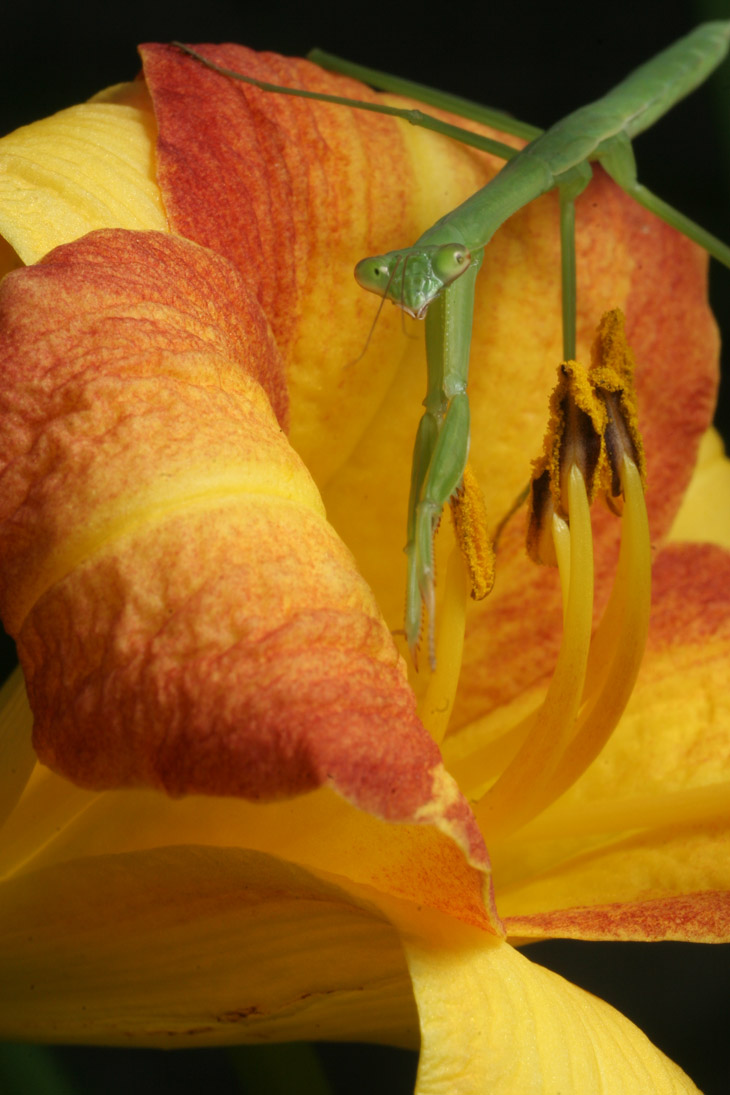
I’m not averse to nudging or outright moving an insect to a position that works better for the photo, as you’ll see soon enough, but this one really was as found, aware of me but not fleeing as I played with angles and lighting, so thank Bob for mantis egos. And yes, the left eye is showing a little damage from an unknown cause.
One of the facets of shooting mantises is that you’re never actually sure if you’re shooting the same one on later days or not, even when it’s the same location; they will wander around, and it’s impossible to know just how many really are in a given area. So maybe this is the same one, and maybe not.

I like trying to capture ‘expressions’ from species that, by all rights, shouldn’t be able to display any such thing, and this is one of them, looking off as if it heard the neighbor’s annoying kid falling into the storm drain: not at all surprised, but resigned to the fact that it’s probably going to have to help get him out anyway. Maybe I’m reading too much into it…
It’s been pretty damn hot recently, even at night, and so the misting bottle serves a dual purpose, not just making for a more photogenic subject, but providing a bit of moisture for them to boot. Before this one had a chance to clear the faux dew from its eyes, I captured a moody composition almost by accident, as the light angle and strength wasn’t as originally intended. It made the tight crop pretty interesting though, or at least I think so.
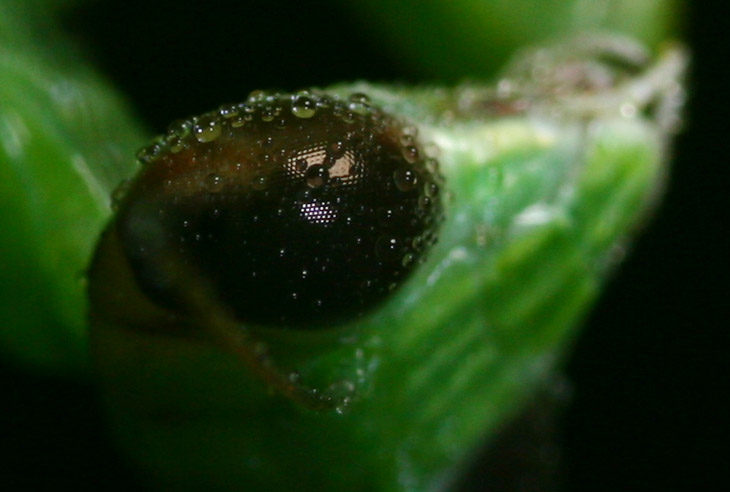
And this next one I was trying to set up for days. The egg sac that they had emerged from (most likely, anyway – there’s always a chance there was another that I remained unaware of,) had been sitting in the same place under the Japanese maple the entire time, but I was thinking that a comparison shot, like last year’s, might be a nice thing to feature. Except that none of the mantids seemed inclined to pose with it, or even be anywhere near it. So when I found one hanging out among the lilies, I simply uprooted the twig I’d tied the egg case to (this being one of three that I’d purchased when I could find none naturally on the property,) and replanted it near the mantis. This sent the mantis into hiding, so I let it be for a bit to calm down again, and perhaps pose helpfully alongside the case. But no, the mantis moved much further away (less than a meter, but still far enough that convincing it to get near the sac would be problematic.) I tried again a few days later when I spotted one again, with much the same results. Then I moved it to a location they seemed to like to visit, but they avoided that area thereafter. Finally, I moved the twig close to one mantis who, later on, was found right underneath the sac itself. So, you say, a simple matter of coaxing the mantis up a little and onto the egg sac, no? Ah ha ha ha ha ha, you naive fool! I say rather callously. You have not done much arthropod wrangling, have you? No, I have a fucking life, you shoot back with ruthless delight…
Getting the mantis to pose by the egg sac for a simple scale shot took several attempts, as the mantis shot past the sac and well up the twig, or jumped clear onto another plant nearby, or jumped from my hands as I transferred it back, but eventually I was successful. So now you can compare this against the pics (and exciting video!) from the hatching. Kind of, anyway – there are no images of the entire sac in there.
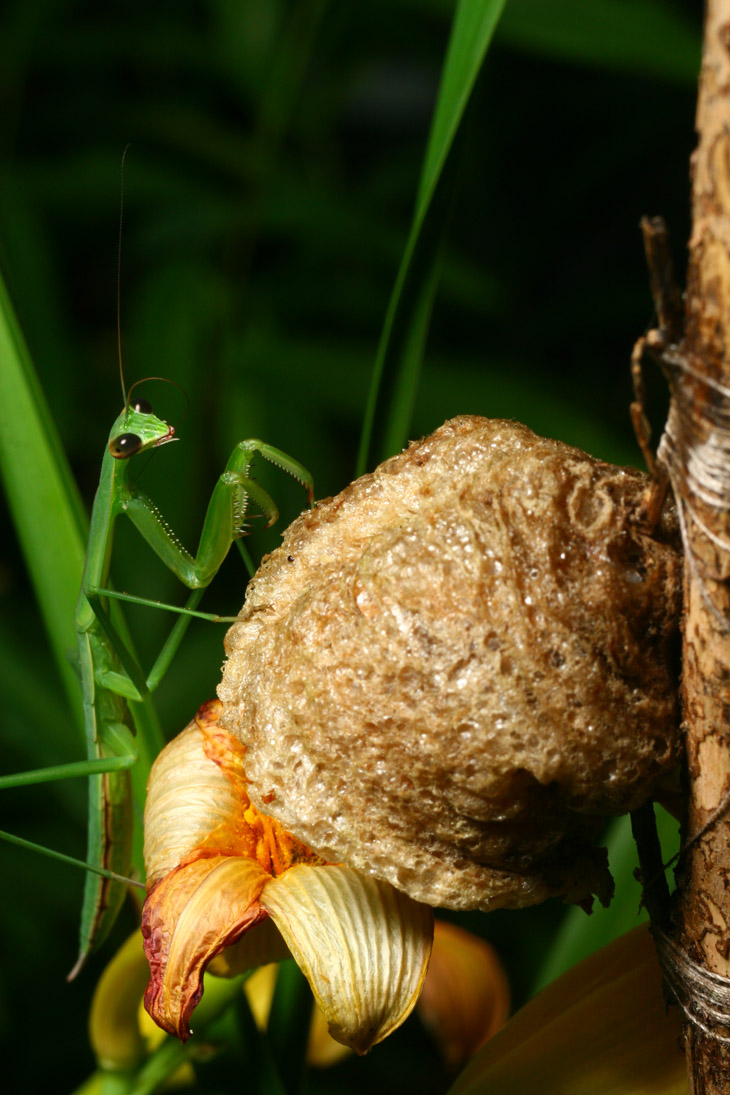
The mantis is 60mm long, about six times their length at hatching, and nowhere near adult size yet. By the way, I have to point out the antenna in the mouth, being cleaned (along with its feet) after its icky icky contact with humans. This is quite common in the insect world.
The next one is something I’ve never seen before, and responsible for a vocal “Holy shit!” when I first spotted it. This says a little in itself, since I’m usually making the effort to remain silent when out shooting. You know, good habits and all that.
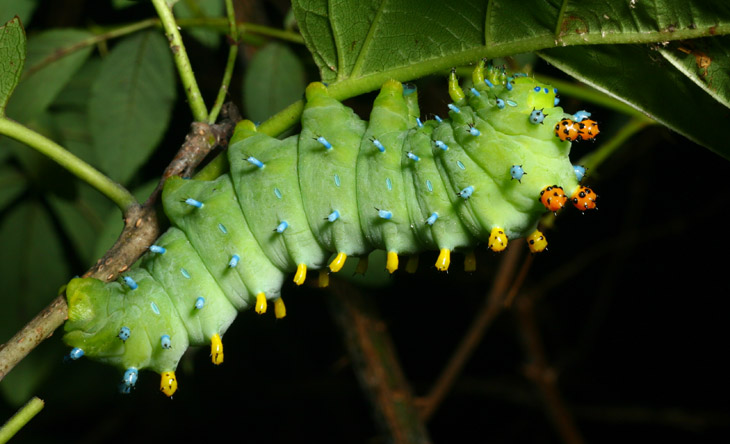
This is the larva (caterpillar) of a cecropia moth, Hyalophora cecropia, and while it’s colorful that’s not the reason for the cussin’ – it’s huge, the largest caterpillar I’ve ever seen, easily outweighing the hornworms I would find routinely on the tomato plants.
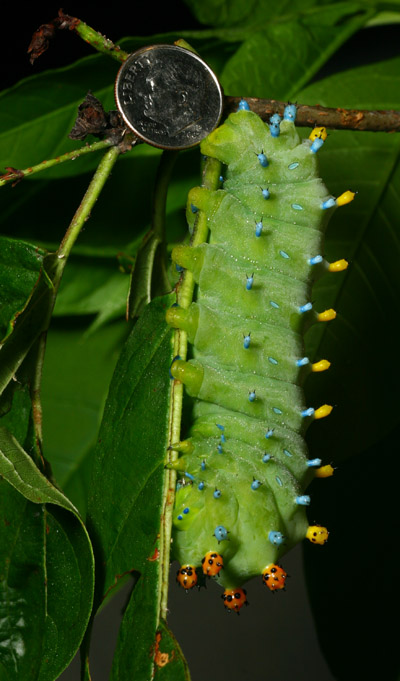 This image might help more than my telling you it was larger in diameter than my thumb and in excess of 100mm long – it’s hard to get an exact measurement of something that stretches and contracts routinely, especially when it starts getting shy and withdrawing its head as much as possible. Yes, those little bedazzler knobs are spiky, but according to the immensely useful BugGuide, they’re not supposed to have any venom in there. I made it a point of not confirming this, partially because when I collected it I hadn’t yet looked it up to determine species, but also because I wasn’t exactly sure I had the right species identification, and also wouldn’t put it past those sneaky entomologists to set up nature photographers like that. There’s always been a bitter rivalry between entomologists and nature photographers*
This image might help more than my telling you it was larger in diameter than my thumb and in excess of 100mm long – it’s hard to get an exact measurement of something that stretches and contracts routinely, especially when it starts getting shy and withdrawing its head as much as possible. Yes, those little bedazzler knobs are spiky, but according to the immensely useful BugGuide, they’re not supposed to have any venom in there. I made it a point of not confirming this, partially because when I collected it I hadn’t yet looked it up to determine species, but also because I wasn’t exactly sure I had the right species identification, and also wouldn’t put it past those sneaky entomologists to set up nature photographers like that. There’s always been a bitter rivalry between entomologists and nature photographers*
In both of these pictures so far, the caterpillar was still reacting to my messing about, and had its head tucked down – the orange knobs are anatomically in line with the yellow ones running down the back, so they’re an indication of how curved the spine would be, if it had a spine. The head is completely hidden in both shots, but we’ll correct that very soon. Not quite yet, though.
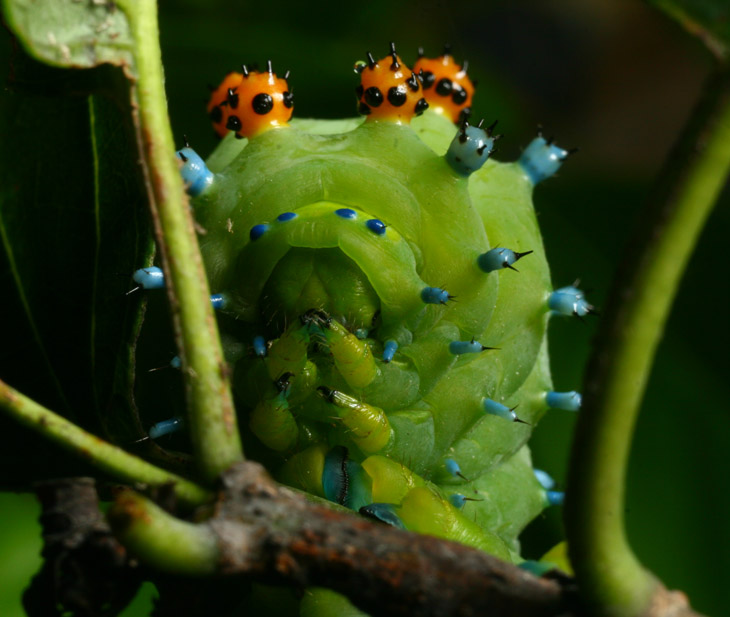
This was a typical pose when I was trying for detail shots; any disturbance of the twig caused it to withdraw its head and bring up the forelegs for protection. Or maybe it was raising its dukes for a boxing match – I’m not going to assign motivations to a caterpillar, I’ve been burned on that before.
By the way, between each of its main legs possessing dozens of tiny claws for gripping, and the obvious (if potentially false) threat of those knobs, I simply cut the small branch that it was on to bring it in for photographs. Yeah yeah, I know, don’t disturb nature and all that. The branch was in the process of being totally denuded of all leaves by the caterpillar itself, and sits on the edge of a manmade pond that routinely gets trimmed back and shaped and mowed and so on – seriously, there are bigger things to worry about. Like when the caterpillar finally gets fed up and starts to charge!
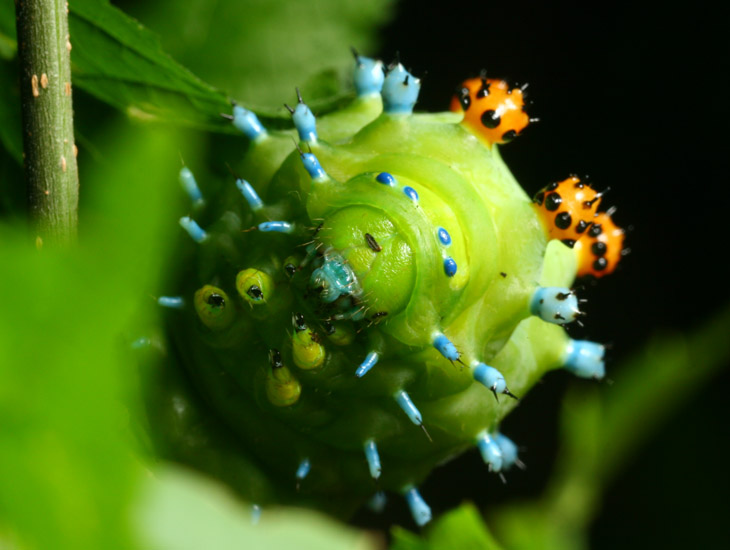
Yep, that’s me (not in the pic, of course,) holding steady to get the crucial photos until the very last minute. And did you get the joke about “fed up”? Don’t lie to me, I know you missed it.
Actually, to get this I had to transfer it to a branch out in the yard and then sit and wait for it to feel safe enough to emerge and start moving forward – and then I had to endeavor not to disturb the branch by bumping it with the flash unit, something I failed to do several times, each time sending the caterpillar back into defensive mode. It took a while, I can tell you, and it’s hot out there. You’d better appreciate this.
But my favorite is another semi-staged photo. While waiting with mixed patience for the cecropia to emerge again, I spotted another larva nearby (of the kind typically referred to as “inchworm”) and deposited it on the branch, where it ambled forward and across the feet of the cecropia then paused, perhaps aware that it wasn’t walking on bark anymore. I couldn’t resist the comparison image, but I suppose it helps to know that the giant green mass is another caterpillar and not, you know, a diseased pepper or something…
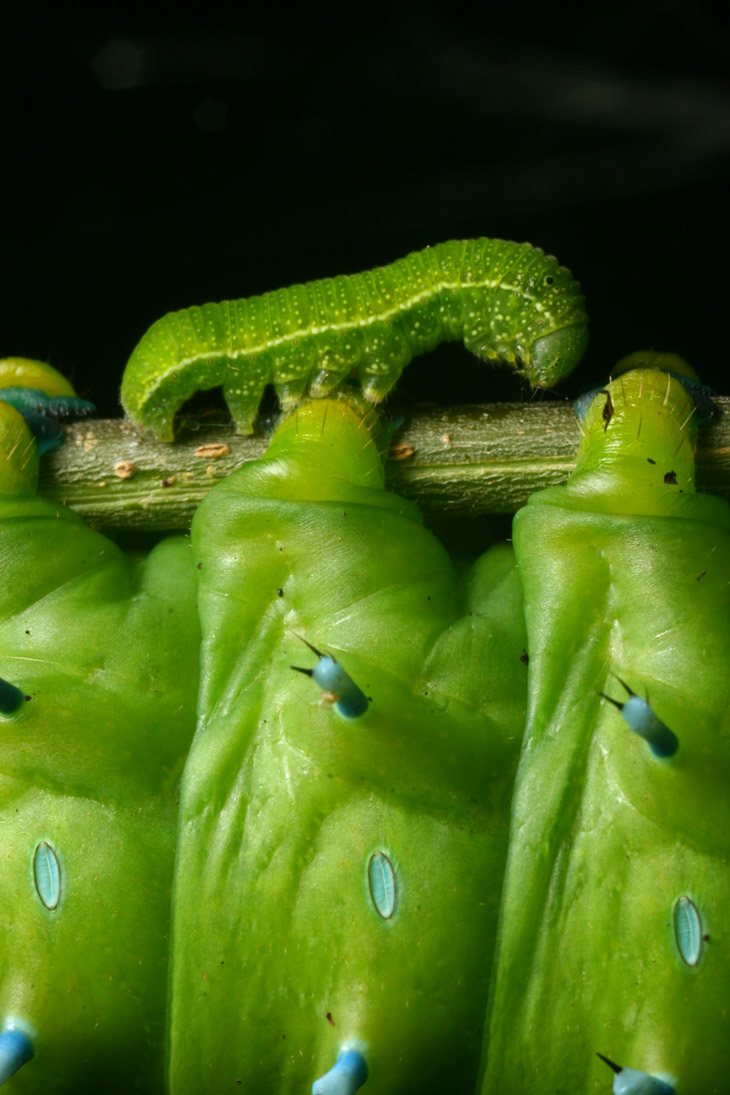
* You should know by now that any such statement followed by an asterisk means it’s completely false. There’s no bitter rivalry between nature photographers and entomologists – we feel they’re completely beneath notice.




















































